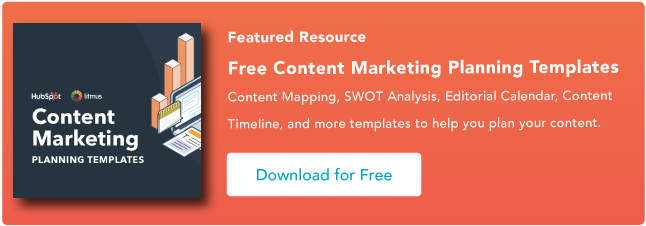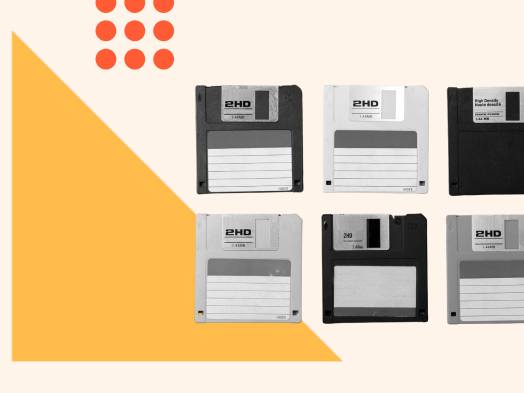Have fun diving in to this glossary of terms -- and if we missed any, leave your definitions in the comments below!
A
Agile
Having the ability to move quickly in the world of content creation is a necessity for inbound marketers. Not only does it enable you to respond to opportunities quickly -- like newsjacks, for example -- but it helps you recover from failures quickly, too. (And trust me, there will be failures.)
Agility is the difference between a content marketing strategy that succeeds and one that falls flat, so work on adjusting on the fly. This post can help you become more agile.
Analytics
Making use of analytics is the only way you'll have insight into which content is working -- or falling flat. Ideally, you'll make use of a closed-loop analytics solution so you're able to see what happens to all that site traffic. Think about how cool it'll be to tell your boss that your blog post actually generated not just a site visit, not just a lead ... but an actual paying customer!
B
Blogging
Blogging is a core component of content marketing, driving site traffic, quality leads, and establishing your position as a thought leader in your industry. Your business blog should be built from a foundation of topics and keywords that you've discovered are important to your audience, and that help solve the challenges that your readers face. This means that promotional posts should be subtle and rare.
Buyer Persona
Knowing your audience is vital to your success in content marketing -- buyer personas help you do just that. They're little snapshots of your target audience that allow you to create content that speaks to their specific needs.
We've written tons of content around building your buyer persona, but this blog post in particular is very detailed on the subject. It even includes a template you can use to guide you through building your own personas.
C
Calls-to-Action
Calls-to-action are a critical part of your content marketing, because they help convert all that site traffic you're driving through content creation into actual contacts in your database. While not every piece of content you create requires a lead-gen call-to-action, your content should include some sort of CTA -- whether to share your content on social, subscribe to your blog, or check out another page on your site.
Clickthrough Rate
Clickthrough rate (CTR) is one of the metrics that shows how engaged readers are with your content. Did they click on the CTA at the end of the blog post? Did that visitor turn into a lead? Did they even open the post?
This data can inform how you approach content creation, giving insight into which content types and subject matters are most appealing to your readers -- and even what type of copy they enjoy reading.
Conversion Rate
Traffic is great, but every business needs new customers to sustain itself. Conversion rates give you an idea of how good you are (or how good your content is) at converting visitors into leads, or leads into customers. (Those are two of the most typical conversion rates content marketers measure, anyway. But feel free to get creative!)
Crowdsourced Content
Creating your own content can take more time than you have to lend to it. That's where crowdsourcing comes into play. Allowing subject matter experts, customers, or freelancers to create your content for you is a prime way to get more quality content published in less time. Compile the content you get back into a really awesome offer and give credit to all the contributors -- a win-win for everyone involved.
D
Data-backed Content
Backing up your claims in content with up-to-date and accurate data makes every piece of content stronger, and can help you establish authority when writing controversial or thought leadership content. Make sure you note your source and link back to it to avoid getting into any hot water if your claims are found to be incorrect.
Tip:Factbrowser is a great tool to find industry-specific data for your content.
Dynamic Content
Dynamic content is a way to display different messaging on your website based on the information you already know about the visitor.
For example, you could use Smart CTAs so that first-time visitors will see a personalized CTA (perhaps with a top-of-the-funnel offer) and those already in your database see a different CTA (maybe for content that offers a little more information about your product or service).
Read this post to learn more about how you can use dynamic content to make your marketing more personalized.
E
Ebooks
Ebooks are a common type of content that many marketers use -- often to help generate leads. They are generally a more long-form content type than, say, blog posts, and go into in-depth detail on a subject.
This blog post takes you from start to finish on creating an ebook.
Editorial Calendar
An editorial calendar is like a road map for content creation, showing you what kind of content to create, what topics to cover, which personas to target, and how often to publish to best support your inbound marketing strategy.
Maintaining an editorial calendar will keep you more organized and show you any gaps you may have in your content library. It also helps ensure you're doing the right things for your personas and not going way off-track with the topics you're covering.
Don't have a proper calendar of your own yet? Check out this free, pre-designed editorial calendar template.
Evergreen Content
Evergreen content is content that continues to provide value to readers no matter when they stumble upon it. This post serves as a prime example. These posts are typically a content marketer's best friend because of the tremendous SEO value they provide.
Experimental Content
Content can take many different formats, which opens up lots of opportunity for experimentation. For example, HubSpot experimented with offering stock photography instead of the tried and tested ebooks, and it was a huge hit with our audience. While you should continue to do what works to ensure you hit your numbers, you should also try to take a risk with your content once in a while. You never know what success it might yield.
F
Facebook is a social network you're likely quite familiar with already -- but it has become so much more than just a platform to publish content and gain followers. You can now utilize the awesome targeting options available through Facebook advertising to find and attract brand new contacts to your website and get them to convert on your landing pages ... but remember, you still need awesome content to do it.
We created this ebook on how you can use all of the super cool targeting functionality on Facebook to grow your database, if you're looking for more information on how to take your content marketing to the next level through Facebook.
Formats
It's always a good idea to try and find new ways to deliver your content. Have you tried video? Webinars? Google Hangouts? Facebook or Twitter Chats? An email tip series? Podcasts? SlideShares? Try out a few and see what works best for your audience. A little bit of research on where your audience is hanging out will help you with this one.
G
Google+
Google+ is a social network that allows you to join and create circles in which you can mix and match family members, friends, colleagues, and fellow industry members. While you can use it much like other social networks -- to publish and share content, and generate new leads -- it also provides content marketers with tremendous SEO value due to the rising importance of social sharing in search engine algorithms. (It is owned by Google, after all.)
H
Hashtag
Hashtags are a way for you and your readers to interact with each other on social media and have conversations about a particular piece of content.
It's a good idea to create a hashtag for every big piece of content you publish online, and subsequently promote on social so you can spark conversations and monitor them easily. (Social Inbox will also help you with that!)
I
Inbound Link
An inbound link is when another website picks up your content and links back to it from their site. It's one of the many criteria for great SEO that Google's algorithm takes into account, because it's a sign that your content is high-quality.
Influencers
Every industry has influencers -- people that the rest of us look up to because of their experience and intelligence. Knowing who these influencers are helps content marketers stay on top of trends and learn more about their industry. If you happen to have a relationship with an industry influencer, you might consider broaching the subject of co-creating some content together -- it could help you increase your own authority and reach in your industry.
Infographic
An infographic is a highly visual piece of content that is very popular among digital marketers as a way of relaying complex concepts in a simple and visual way. Read more about how to create a knockout infographic here.
Though initially a haven only for younger generations who wanted to post, edit, and share unique-looking photos, Instagram has grown into a premier social network that's a viable opportunity for content marketers. Many businesses are taking advantage of the site by posting industry related photos that their followers and customers would enjoy seeing.
K
Keywords
A keyword -- or keyword phrase -- is what a search engine user inputs when looking for information. Keywords are important for content marketers because the keywords your target audience are typing into search engines are typically good topics to create content about. Spend some time carefully, and analytically, picking keywords (both short and long-tail) to optimize your content and website pages. Here are some tips on getting started with keywords.
L
Landing Pages
Landing pages are the epicenter of your lead generation. For the purposes of content marketing, they are where your lead-gen content assets live so you can convert more visitors into leads, and leads into customers.
Lifecycle Stages
Lifecycle stages are helpful ways to describe the relationship you have with your audience, and can generally be broken down into three stages: awareness, evaluation, and purchase.
What's important to understand about each of these stages is that not every piece of content you create is appropriate, depending on what stage your audience might fall in at that moment. That's why dynamic content is so great -- you can serve up content that's appropriate for whatever stage that particular visitor is in.
Learn more about how to map content to lifecycle stages in this blog post.
LinkedIn is a social network that allows people and businesses to connect with one another. It's particularly popular for B2B marketers, though some B2C marketers have found it helpful, too. One major marketing benefit of LinkedIn is their Company Pages -- not too dissimilar from Facebook business pages -- that allow businesses to promote themselves and broaden their following. Many marketers also see great results from LinkedIn Groups, which are excellent places to share and discuss content with others in your industry.
N
Newsjacking
Newsjacking refers to the practice of capitalizing on the popularity of a news story to amplify the impact of a piece of content. For instance, if Google releases an algorithm update, we here at HubSpot would want to blog about it because 1) it impacts our audience, and 2) Google rewards those who cover news items quickly and comprehensively by bumping up their placement in the SERPs.
Next time you come across a big news story that has a tie-in to your industry, see if you can find a way to cover it with your own helpful, relevant spin.
O
Offers
Offers are content assets that live behind a form on a landing page (i.e. they help you generate leads for your business).
If you need help putting together some high-quality offers your buyer personas will love, take some time to read over this post.
P
Personalize
In content marketing, personalization means creating and delivering content -- blog posts, emails, social posts, etc. -- with both the persona, and the lifecycle stage of that persona, in mind.
Pinterest is a visual social network typically used by ecommerce marketers, but not without its fair share of top-notch B2B and B2C content marketers. Businesses and consumers alike use the website to post images and photos they like so fellow users can repin (share) that content.
Not every company has taken advantage of this site yet, and if you're one of them, we advise you check out this offer to understand the benefits Pinterest can offer.
Promotion
Spend the same amount of time planning the promotion of your content as you do developing it. That means you should be using all the channels at your disposal -- like email, social, your blog, even PPC -- to get eyeballs on your content.
Q
Quality
If you Google "ebook," within 20 seconds, you'll have over 170 million search results to choose from. But how many will you actually look at, never mind exchange your personal information for?
With the increasing popularity of content, there's now a bigger need than ever to ensure that your content is jam-packed full of value. Don't create content for content's sake -- take your time and make sure to keep a super high standard of quality in everything you publish. That way, your readers will keep coming back for more and sharing your content with their network.
Quantity
Establishing the right quantity of content to create and share is also important to grow and maintain your audience. Not every business needs to create and share content at the same velocity, though. Choose the frequency that's right for your business, and stick to that schedule relatively consistently so your readers know what they can expect from you.
S
Social
Get active on social media. Don't simply use it to push out your content, but when you do share your content, make sure you create a hashtag that enables you and your readers to interact with each other.
Take advantage of the broad spectrum of social sites that are out there today -- yes, Facebook and Twitter are the obvious ones, but do your due diligence on the merits of using platforms like Google+, Pinterest, Instagram, etc.
Social Optimization
You can optimize every piece of your content for sharing by adding social sharing icons, email-to-a-friend buttons, and lazy tweets. Make it ridiculously easy for your readers to share your content, because if you don't provide the option, the chances of them doing the work for you are pretty slim.
T
Templates
Seems like a pretty obvious one, but the development of content ain't easy. Don't be afraid to get help -- use our content blueprint to access tons of tools and templates for developing your content.
Want to share news with your followers? Chat with customers? Give a quick shoutout to some partners? Twitter's the place to be. The social network allows for 140 character posts that you can share with the world -- images and multimedia content welcome, as well.
V
Visual Content
Visual content is critical for content marketers who want to catch their prospects' attention. Invest in things like infographics, videos, and data visualizations to help make your content more interesting to consume.
Y
YouTube
YouTube is a very popular platform for hosting your videos, because it has a pre-existing audience for you to tap into. Video marketing is effective for generating traffic to your main website, building brand buzz, and building a social media presence.
There are lots of tools out there now to help you create awesome videos without breaking the bank, too. For screen recording, try Camtasia. For free editing, try iMovie for Mac or Windows Live Movie Maker.
Z
Zerys
Zerys is a nifty little community of writers who want to create your content for you! If you're stuck for time or resources, you can use Zerys to contract a writer.
Freelancers have proven to be excellent resources for marketing teams all over, so if you don't think you can handle content creation internally, look into some outsourcing options.
What are some other core content marketing terms you think should make this list? Share your suggestions (and definitions) in the comments!
Content Marketing


.webp?width=618&height=510&name=analytics-sources%20(1).webp)

-1.webp)
![How to create a content style guide [+ free guide & examples]](https://53.fs1.hubspotusercontent-na1.net/hubfs/53/image1-May-07-2024-07-15-58-1152-PM.webp)







